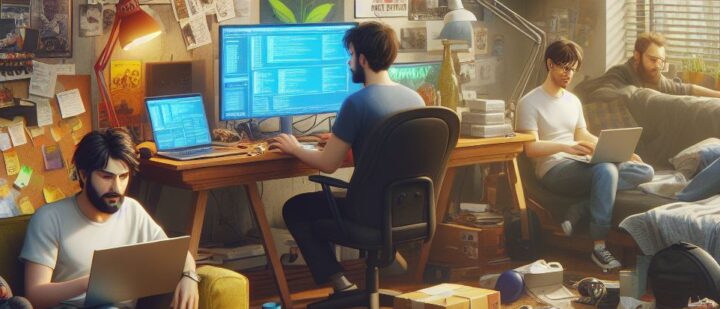Video Game Design: The Masterminds Behind Games
Have you ever dreamt of stepping through a shimmering portal, a gateway to a universe crafted from pixels and imagination? That’s the magic of video games, and the masterminds behind these fantastical experiences are video game designers.
But just like a delicious pizza requires a team effort from the dough-slinging chef to the cheese-grating maestro, video game design is a collaborative art form with many specialized roles. So, grab your metaphorical toolbox, fire up your creative engines, and get ready to delve into the captivating world of video game design disciplines!
The Master Architects: Video Game Designers
Think of game designers as the head chefs of the development kitchen. They concoct the core concept, the recipe for fun, and decide what kind of experience they want players to have: Will it be a heart-pounding puzzle adventure like Portal, a side-splitting party game like Mario Party, or something entirely new like Minecraft? Brainstorming ideas, crafting the rules, and weaving the narrative threads that hold the game together.

Storytelling in Pixels: Narrative and Content Designers
Every great game has a story, even if it’s not a sprawling epic. Narrative designers are the wordsmiths who craft the game’s plot, characters, and lore. They collaborate with content designers who flesh out the world with in-game text, dialogue, and item descriptions. To learn more about the magic of narrative design in games, explore the articles at https://www.thecreativepenn.com/2021/08/30/narrative-design-in-the-gaming-industry.
The Map: The Level Designer’s Domain
Level designers are the Michelangelos of the digital world, sculpting the individual levels or worlds that players explore. They meticulously craft the landscapes, like lush forests or sprawling cities. They position enemies strategically, like pawns on a chessboard, and design puzzles that will have players racking their brains (in a good way!). For a deeper dive into level design, check out the informative guide by the Game Design Institute: Level Design – Game Design Institute: https://catalog.gameinstitute.com/collections/game-development-courses

Programming the Playground: Gameplay Programmers
Imagine a game without interactivity– like a movie on pause, right? Gameplay programmers are the code wizards who bring the game mechanics to life. They translate the game designer’s vision into code, ensuring the game runs smoothly and responds to player input – the magic behind that satisfying jump or perfectly timed attack.
The User-Friendly Interface: UI/UX Designers
Have you ever needed help navigating a confusing menu in a game? That’s where UI/UX designers come in. They’re the architects of the user interface (UI) – the menus, screens, and buttons players interact with – and the user experience (UX) – how easy and enjoyable it is to navigate the game. They ensure the interface is intuitive and doesn’t feel like deciphering an ancient scroll. To better understand UI/UX design in games, check out the User Interface Design for Games course on Interaction Design Foundation: https://www.interaction-design.org/literature/article/work-in-games

The Soundtrack to Your Adventure: Sound Designers
Imagine slaying a dragon in complete silence. Not as epic, right? Sound designers are the invisible orchestra conductors, crafting the sound effects and music that immerse players in the game world. From the satisfying clang of a sword to the haunting melody in a spooky forest, sound design adds emotional depth and makes the game world feel truly alive.
Bridging the Gap: Technical Designers
Technical designers are the interpreters, the folks who bridge the communication gap between video game designers and programmers. They document game mechanics and systems, ensuring everyone’s on the same page and the programmers can translate the design into code.

Beyond the Core: A World of Specialists
The world of video game design is vast and ever-evolving, with new specialisations emerging constantly. But games are not just ideas, and each role offers a unique opportunity to contribute to the game’s creation and to be a part of this dynamic industry.
- Environment Artists: These digital artists bring the game world to life by creating the landscapes, buildings, and other visual elements that players explore.
- Character Artists: Just like in a movie, games need characters! Character artists design the appearance of the game’s heroes, villains, and everyone in between. They breathe life into the game’s personalities through facial expressions, clothing styles, and unique features.
- Animators: Animation breathes life into the characters and objects in a game. Animators create the movements and actions that make the game world feel dynamic. Whether it’s a character running through a field or a flag fluttering in the wind, animators bring that visual magic to the screen.
- 3D Modelers: The building blocks of the game world! 3D modellers create 3D models of characters, objects, and environments that are used in the game. Their skills are essential for crafting everything from a player’s spaceship to a treasure chest filled with loot.
- Technical Artists: These artists work closely with programmers to ensure the visual elements of the game run smoothly and efficiently. They optimise textures, lighting, and special effects to make the game visually stunning without sacrificing performance.
- Network Programmers: In online games, the magic happens not just on your screen but also behind the scenes. Network programmers are the masterminds behind the online infrastructure, ensuring smooth communication between players in a multiplayer world.
- AI Programmers: Ever wonder how those enemies seem to have a mind of their own? AI programmers are the specialists behind artificial intelligence (AI), which controls non-player characters (NPCs). They create the algorithms that dictate how NPCs behave, making them seem more intelligent and challenging opponents.
- Testers: These quality assurance specialists play the game extensively to identify bugs and glitches, ensuring a smooth and enjoyable experience for players. They have a keen eye for detail and a knack for breaking things – in a good way, of course! – to iron out any kinks before the game is released.
- Community Managers: The bridge between players and developers, community managers foster a positive and engaged online community around the game. They interact with players on social media, answer questions, and provide updates on the game’s development.
- Localisation Specialists: The world of gaming is global! Localisation specialists adapt games for different regions, translating text, audio, and cultural references to make the game accessible to a broader audience.
- User Researchers: Understanding what makes players tick is vital to creating engaging games. User researchers conduct studies and surveys to gather player feedback and identify trends. This valuable information helps designers create games that resonate with their target audience.
Whew! That’s quite a crew, isn’t it? Each role plays a vital part in the grand orchestra of video game development.

Finding Your Place in the Game
Whether you have a passion for storytelling, a knack for coding, or an artistic eye, there’s a spot for you in the exciting world of video game design. The best part? There are tons of resources available online and in libraries to help you hone your skills and learn more about this ever-growing field.
Here are some resources to get you started:
- Game Developer Magazine: https://gamedeveloper.com/
- The International Game Developers Association (IGDA): https://igda.org
- Udemy Game Development Courses: https://www.udemy.com/topic/game-development/
- Khan Academy Programming Courses: https://www.khanacademy.org/computing/computer-programming
So, if you’ve ever dreamt of crafting your own digital world, there’s no better time to dive in and start exploring! Remember, the only limit is your imagination – so grab your tools and start designing! You might just be the next mastermind behind the game that takes the world by storm.
Want to take your passion for games to the next level?
This other article dives into the exciting world of indie game development and equips you with the knowledge and resources to turn your dream game into a reality!
